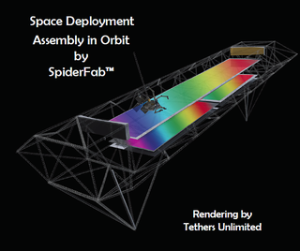THE MOST Space Telescope
 [Disambiguation: this page is about The High Étendue Multiple Object Spectrographic Telescope, not Canada's MOST space telescope]
[Disambiguation: this page is about The High Étendue Multiple Object Spectrographic Telescope, not Canada's MOST space telescope]
Few telescopes can honestly say they've reinvented the concept, yet THE MOST certainly has. It works on a surprisingly old principle, by passing light through two prisms. As Isaac Newton demonstrated, this first splits light into its constituent components, then recombines it back again.
What's the point of that? You might well ask, and the answer is both intriguing and compelling: as the light emerges from the second prism, the focal distance can be controlled to a short distance from it.
With conventional mirror-based telescopes, the light is focussed some distance from the primary mirror, and that distance increases with the size of the mirror. Sending big things into space is both difficult and costly, and there is a reason why the Hubble Space Telescope is limited to the size it is. Additionally, sending a mirror into space is incredibly fraught with potential for disaster - a single crack or pit in the mirror and it can be ruined, and launching is a period filled with heavy vibration.
THE MOST (The High Étendue Multiple Object Spectrographic Telescope) resolves these issues. It uses a material that can be rolled up for launch and unrolled for deployment. It does not have to have the same tolerance for surface errors as a mirror, and is much lighter. Once in space, it is rigged to a framework printed on a 3D printer.
A small mirror catches the starlight as it emerges from the prism and directs it to the secondary prism. A small “grazing” angle allows this to occur very close to the primary prism surface. Further, the telescope can be much bigger and at significantly less cost than a conventional optical or radio telescope. Even better yet, it covers a vast area of the sky in detail without sacrificing angle as other telescopes do when they 'zoom-in'.
With conventional telescopes, the size of the spectrographic collector (mirror for optical telescopes, dish for radio telescopes) is limited to the diameter of the launch vehicle's payload module. With THE MOST, the width of the prism is confined to the length of the payload module, and the length of the prism is limited to how much they can roll up and still fit in the width of the payload module. Size can be increased further by launching the two prisms separately, and as for the printed rig it attaches to, the only requirement is it is there when the prisms arrive. This means the rig can be sent with the prisms or ahead of them, and the rig itself could, in theory, be launched in pieces and assembled in-situ.
If you're interested in astronomy and/or space telescopes, and this isn't giving you goosebumps, check your pulse and be ready to call the emergency services.
https://www.nasa.gov/directorates/spacetech/niac/2019_Phase_I_Phase_II/The_Most/
